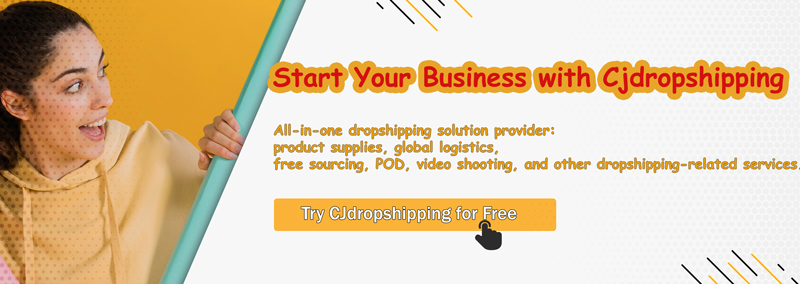Why Your Choice of Dropshipping Website Can Make Your Business
Choosing the right dropshipping supplier isn’t just a detail – it’s the backbone of your e-commerce business. When you dropship, your supplier handles inventory, packaging, and shipping, meaning their performance directly affects your customers’ satisfaction and your brand’s reputation. A delayed shipment or poor-quality product from a supplier can lead to angry customers, bad reviews, and lost sales. On the flip side, a great dropshipping website – one that ships quickly and reliably – can delight your customers and earn you repeat business. In the ultra-competitive world of online retail, your fulfillment partner can truly make or break your store’s success.
Moreover, e-commerce giants like Amazon have set sky-high customer expectations for delivery speed and service. Small dropshippers can’t usually do same-day delivery, but partnering with the right supplier can at least ensure your orders arrive on time and as described. In short, your choice of dropshipping website is critical – it determines product quality, shipping speed, fees, and ultimately whether customers trust your business. It pays to invest time in finding a supplier you can trust because a bad supplier can quickly ruin your business, whereas a good one helps you build a strong reputation from day one.
Why Fast Shipping, Low Fees & Reliable Suppliers Matter
When evaluating dropshipping websites, three factors often rise to the top: shipping speed, cost/fees, and supplier reliability. Each of these can significantly impact your profit margins and customer satisfaction:
-
Fast Shipping: Today’s customers expect their orders fast – often within a week or less. Long shipping times (like the 2-4+ weeks common with some overseas suppliers) can lead to order cancellations and unhappy buyers. Fast shipping boosts customer satisfaction; people love receiving products quickly and are more likely to order again when delivery is prompt. In competitive niches, quicker shipping can be a key differentiator that sets your store apart. For example, many dropshipping platforms now work with US/EU warehouses or expedited courier services to deliver in just a few days, aiming to meet the standards set by Amazon Prime-level speeds.
-
Low Fees and Costs: Every dollar in fees or marked-up wholesale costs eats into your profit. Many traditional supplier directories charge membership fees, and some dropshipping apps have monthly plans or per-order fees. Keeping costs low is especially crucial for beginners on a budget. Using free-to-access platforms (like CJdropshiping, which has no membership cost) or supplier networks with low transaction fees means you retain more profit per sale. Additionally, suppliers that negotiate lower product costs or offer wholesale discounts help you maintain healthy margins. In short, a dropshipping site with low fees allows you to price competitively and scale your business faster.
-
Reliable, Quality Suppliers: Reliability might be the most important factor of all. This includes both product quality and trustworthy fulfillment. You need suppliers who consistently deliver the product as described, without defects or surprises. Unreliable suppliers can send the wrong items or low-quality knockoffs, which destroys customer trust. Working with vetted suppliers (for example, those in directories like SaleHoo that pre-screen vendors) or platforms known for quality control can save you countless headaches. A reliable supplier also has transparent policies for stock levels, so you don’t accidentally sell items that are out of stock, and provides good customer support if issues arise. In essence, fast shipping and low fees won’t mean much if the supplier isn’t reliable – you need all three pillars (speed, affordability, trustworthiness) to build a sustainable dropshipping business.
How We Evaluated the Top Dropshipping Suppliers
With hundreds of dropshipping websites and supplier directories out there, how did we narrow it down to the 15 best? We approached our evaluation with a few key criteria in mind:
-
Shipping Speed & Locations: We prioritized suppliers with robust logistics – those that have domestic warehouses or proven fast shipping options. Suppliers with multiple warehouse locations (e.g. in the US, Europe, etc.) can ship from the closest location to the customer, often delivering within 2-5 days in the same region. Fast fulfillment capabilities were a big plus in our rankings.
-
Supplier Reliability & Reputation: We looked at whether the platform vets its suppliers or offers any guarantees. Directories that verify suppliers (e.g. checking business legitimacy or attending trade shows to vet manufacturers) scored well for trustworthiness. We also considered product quality and consistency – suppliers known to work with reputable brands or manufacturers got an edge. Reading user reviews and community feedback for signs of reliability was part of this process.
-
Cost and Fees: Another factor was the cost to use the platform. We included a mix of free platforms and paid services, but they had to justify their fees. Services with free plans or low-entry costs were favored for newcomers. For paid services, we expected strong features or niche value (like unique products or advanced automation) to include them. Essentially, any membership fees, per-order fees, or app costs were weighed against the value provided.
-
Product Range and Niche Selection: We favored “one-stop-shop” supplier networks for general dropshipping and a few specialized suppliers for popular niches. Platforms with a wide variety of products (covering multiple categories) are great for general stores or experimenting with product trends. We also included some niche-focused suppliers that excel in a particular category (like fashion or print-on-demand) where being specialized brings advantages in quality or branding.
-
Integration & Ease of Use: Especially for modern dropshippers, integration with ecommerce platforms (Shopify, WooCommerce, etc.) is a big convenience. We gave points to suppliers that offer easy integration – for example, official Shopify apps or plugins, API access, or automation tools that sync orders. The best suppliers often let you import products and handle orders automatically via your store’s platform. A user-friendly interface and support resources were also considered as part of ease-of-use.
-
Support and Value-Added Features: Finally, we noted any extra features that add value – things like order tracking dashboards, auto-updating inventory, product research tools, or even educational resources for sellers. Good customer support for the merchant (you) was another plus; if a supplier offers 24/7 support or a dedicated agent, it indicates they will help resolve issues quickly.
Using the above criteria, we scoured supplier directories, Shopify app recommendations, user forums, and recent 2024–2025 reviews. We aimed to include a balanced mix of all-in-one platforms, those known for fast shipping, those with lowest costs, and niche specialists. Now, let’s dive into the 15 best dropshipping websites and suppliers for 2025, and see what makes each one stand out.
The 15 Best Dropshipping Websites & Suppliers for 2025
(To make our list easier to digest, we’ve grouped the top 15 suppliers into categories based on their strengths. Whether you’re looking for a general all-purpose platform or a niche specialist, you’ll find options below.)
The All-in-One Powerhouses: Best Overall Dropshipping Websites
If you’re looking for a one-stop solution to source a wide range of products, these all-in-one dropshipping platforms are your best bet. They offer massive product catalogs across many categories, and most provide additional tools like product import, order fulfillment, and even product research under one roof.
1. CJdropshipping – Global Sourcing with Fast Fulfillment

CJdropshipping is a favorite all-in-one platform thanks to its huge catalog and worldwide fulfillment network. CJ connects you directly with manufacturers (many in China) but sets itself apart by operating warehouses in the U.S., Europe, and other regions. This means you can source affordably from overseas while still delivering to customers from a local warehouse when possible. CJ’s platform allows you to request product sourcing (they’ll find items for you), and you can even do things like custom branding and packaging on products. It’s free to use – you pay only the wholesale cost and shipping per order – making it very appealing for beginners. What makes CJdropshipping an all-in-one solution is its smooth integration with platforms like Shopify and WooCommerce – you can import products with one click, and orders get synced automatically for fulfillment.The combination of low-cost products and an option for fast local shipping when stock is available in regional warehouses makes CJdropshipping a powerhouse for those who want it all. (Shipping from a U.S. warehouse can be just 2-7 days, versus 1-3 weeks from China, which gives you flexibility to choose speed or lowest cost for each product.)
2. Spocket – High-Quality US/EU Products, Seamless Store Integration
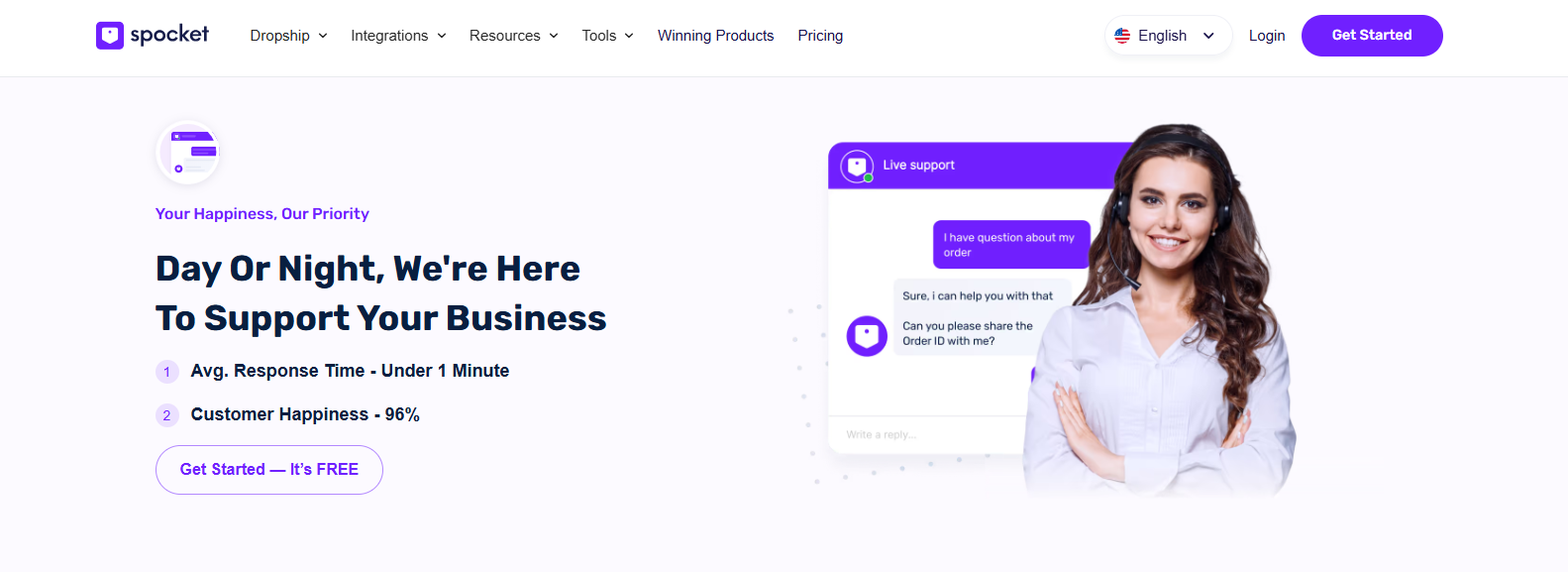
Spocket is another top all-in-one platform, especially if you want high-quality products from US and European suppliers. Spocket’s marketplace includes thousands of products in categories like fashion, home, beauty, and more, but only lists suppliers that can ship quickly to North America and Europe. In fact, most Spocket suppliers ship to U.S./EU customers in 2-5 days, so you’re getting the convenience of domestic dropshipping. The product quality tends to be higher and more curated (you won’t wade through thousands of dubious listings as on AliExpress). Spocket does have paid plans for larger stores, but it offers a free plan to test the waters. It’s recommended for sellers who want a wide selection of trendy, quality items and care about fast shipping and automation. (Many entrepreneurs running fashion or home décor boutiques use Spocket to find unique items not everyone else is selling.)
3. SaleHoo – Trusted Supplier Directory with Market Research Tools
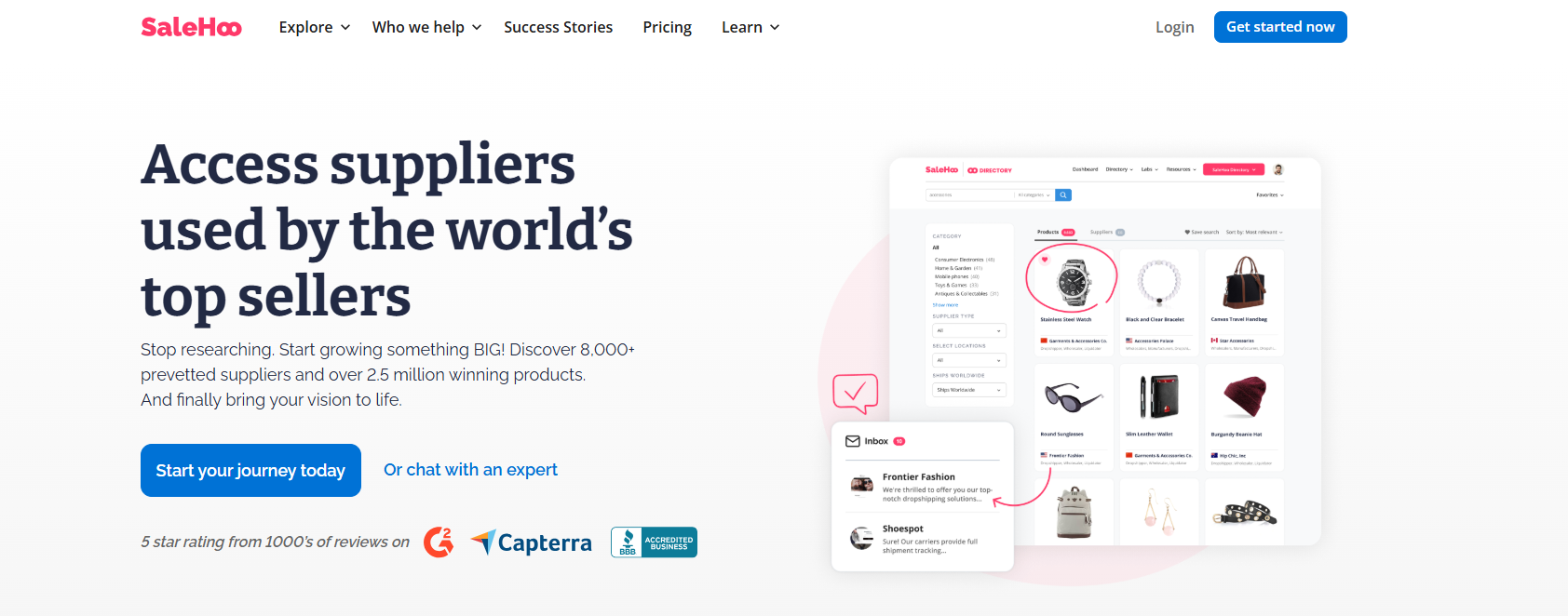
SaleHoo is a bit different – it’s an extensive directory of pre-vetted wholesale suppliers rather than a single supplier or marketplace. SaleHoo has over 8,000 suppliers in its database, offering more than 2.5 million products across virtually every category. The value here is reliability: every supplier is checked and verified, so you’re far less likely to run into scams or counterfeit goods. SaleHoo’s platform also includes a powerful Market Research Lab that helps you identify profitable products (it shows data on product demand, competition, and sell rate on platforms like eBay/Amazon). While SaleHoo traditionally was a directory (with an annual or one-time fee), they also launched SaleHoo Dropship, a service that directly integrates with Shopify for importing products. This service has a monthly fee (around $27 for basic), but it streamlines the process by letting you add products to your store in one click from their curated lists. Recommended for sellers who want trustworthy suppliers and data insights – especially useful if you plan to sell branded products or want to avoid the trial-and-error of finding reliable wholesalers. (For example, using SaleHoo you can filter suppliers by location or niche, and find those that explicitly offer dropshipping with low minimum order requirements.)
Other all-in-one platforms worth mentioning: Doba – a comprehensive platform with over 2 million products that handles ordering and communication with suppliers for you. Doba is great for ease of use (you source and fulfill all in one dashboard) but it requires a monthly subscription. Wholesale2B is another similar aggregator that integrates with multiple store platforms and has over 1.5 million products from 100+ suppliers. Wholesale2B allows you to manage all orders from one account and offers automation for inventory syncing. These services can be very convenient, though many users start with the free options listed above and later consider paid aggregators as they scale.
Speed Demons: Suppliers with the Fastest Shipping Times (US & EU)
One of the biggest challenges in dropshipping is shipping time – nobody wants to wait 3-4 weeks for an item. The suppliers in this category are known for lightning-fast fulfillment, often specializing in domestic shipping (United States, Canada, or Europe) or otherwise optimized logistics. These are perfect if you want to promise your customers Amazon-like delivery speeds.
1. DropCommerce – 3-5 Day Shipping from North American Suppliers
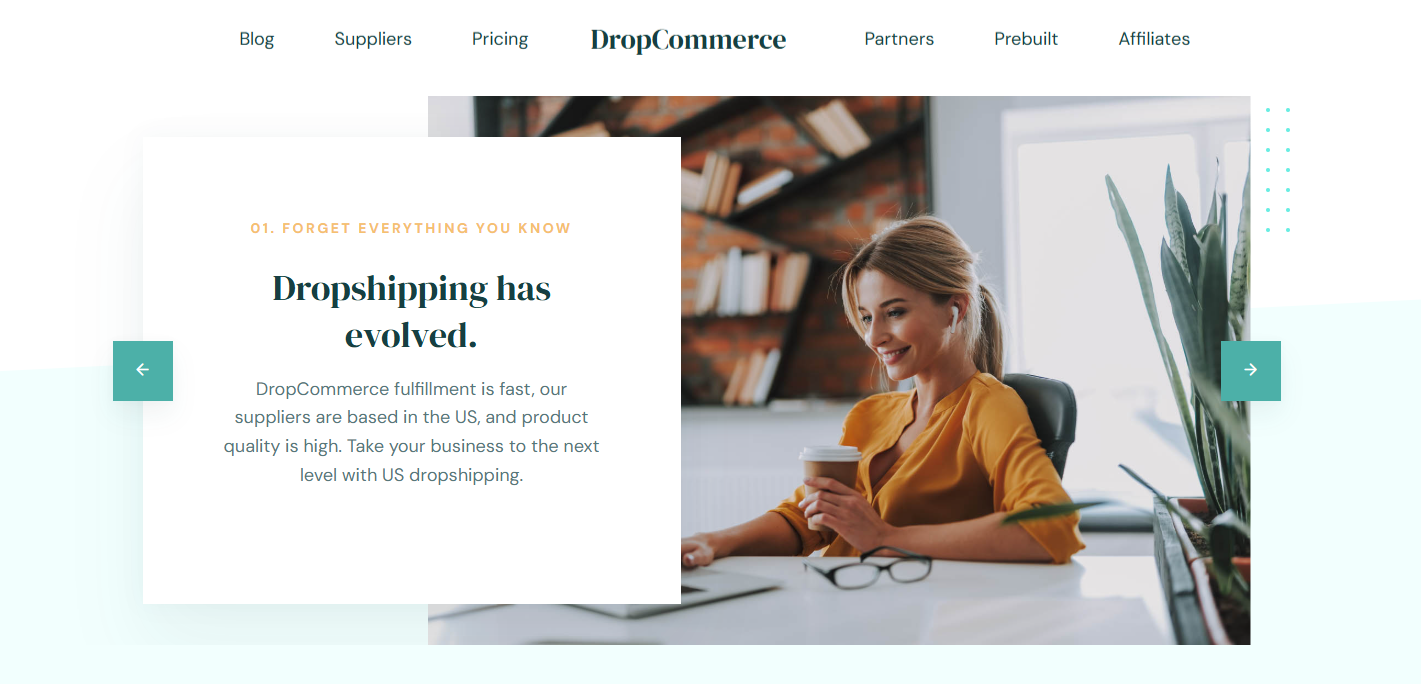
DropCommerce connects you with local US and Canadian suppliers, focusing on quality goods that ship quickly domestically. With a network of 400+ North American suppliers, DropCommerce can achieve delivery in three to five days within North America for many products. This is a huge advantage if your store targets the U.S. or Canada – you can essentially offer nearly week-of delivery. Products on DropCommerce come with a guaranteed minimum 30% profit margin for retailers, and many include features like order tracking and even branded invoicing. The platform integrates with Shopify and others, with a free plan (which allows a limited number of product imports to test it out). If fast shipping in the U.S./Canada is your priority, DropCommerce is an excellent choice. The trade-off is that the product selection, while decent (thousands of items across fashion, beauty, gadgets, etc.), is limited to what those North American suppliers offer – you won’t get ultra-cheap $2 trinkets from China here, for example. But what you do get is speed and reliability.
2. Zendrop – Expedited Shipping from US & Global Warehouses
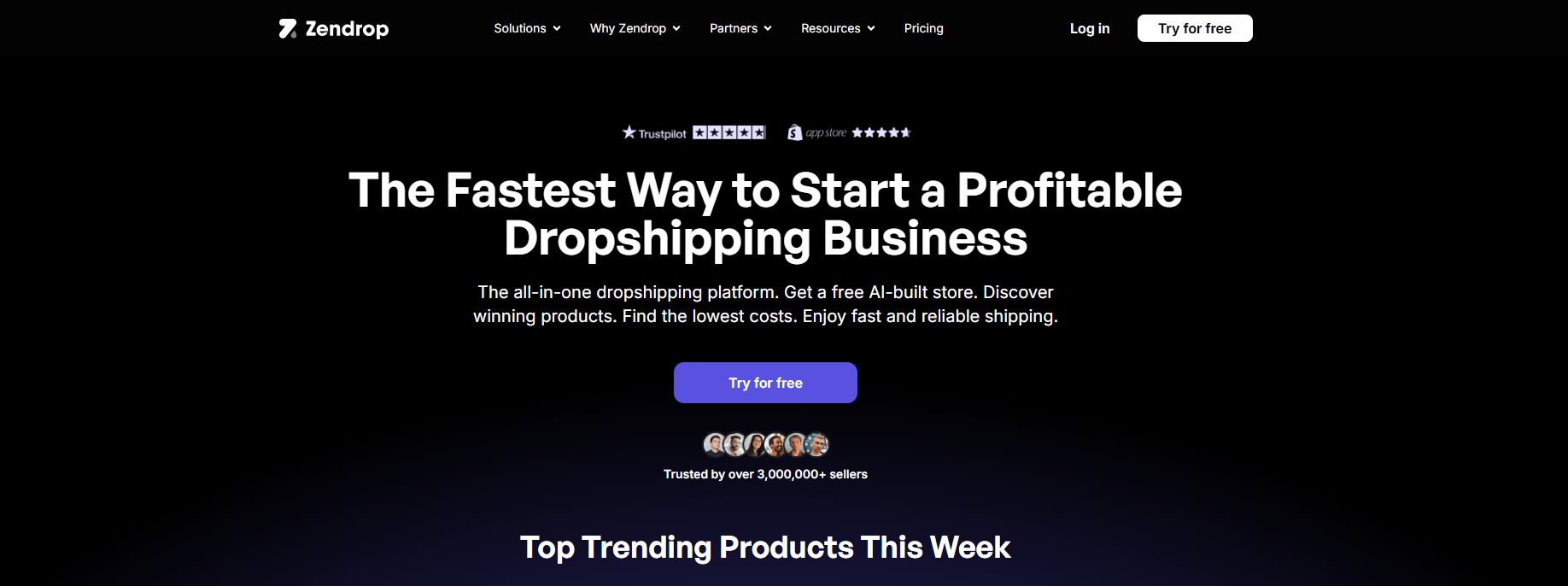
Zendrop is a modern dropshipping platform that emphasizes quick, reliable shipping. It partners with suppliers who can typically ship out orders in less than 5 days. Zendrop sources products mainly from manufacturers in China and the US, but they avoid the slow ePacket routes by using faster courier services and by holding inventory in domestic warehouses when possible. For example, an order from a US supplier on Zendrop might reach your customer in 3-5 days, whereas from China it might be 7-15 days (still faster than the 20+ days often seen on AliExpress standard shipping). Zendrop integrates directly with Shopify (and other platforms via an app), automating your fulfillment – when you get a sale, it routes the order to the supplier automatically for you. It also provides nice perks like auto-tracking updates to customers and even an option to create custom branded packaging inserts for your orders. Zendrop has a free plan to start, with premium plans that unlock more products and features. This platform is great for beginners who want faster shipping without dealing with suppliers one-by-one, and it’s recommended for sellers looking to ship trending products quickly. (Imagine being able to add that hot TikTok gadget to your store and deliver it to US customers within a week – Zendrop’s model is built for that agility.)
3. Sellvia – Ultra-Fast US Shipping (5 Days Globally)
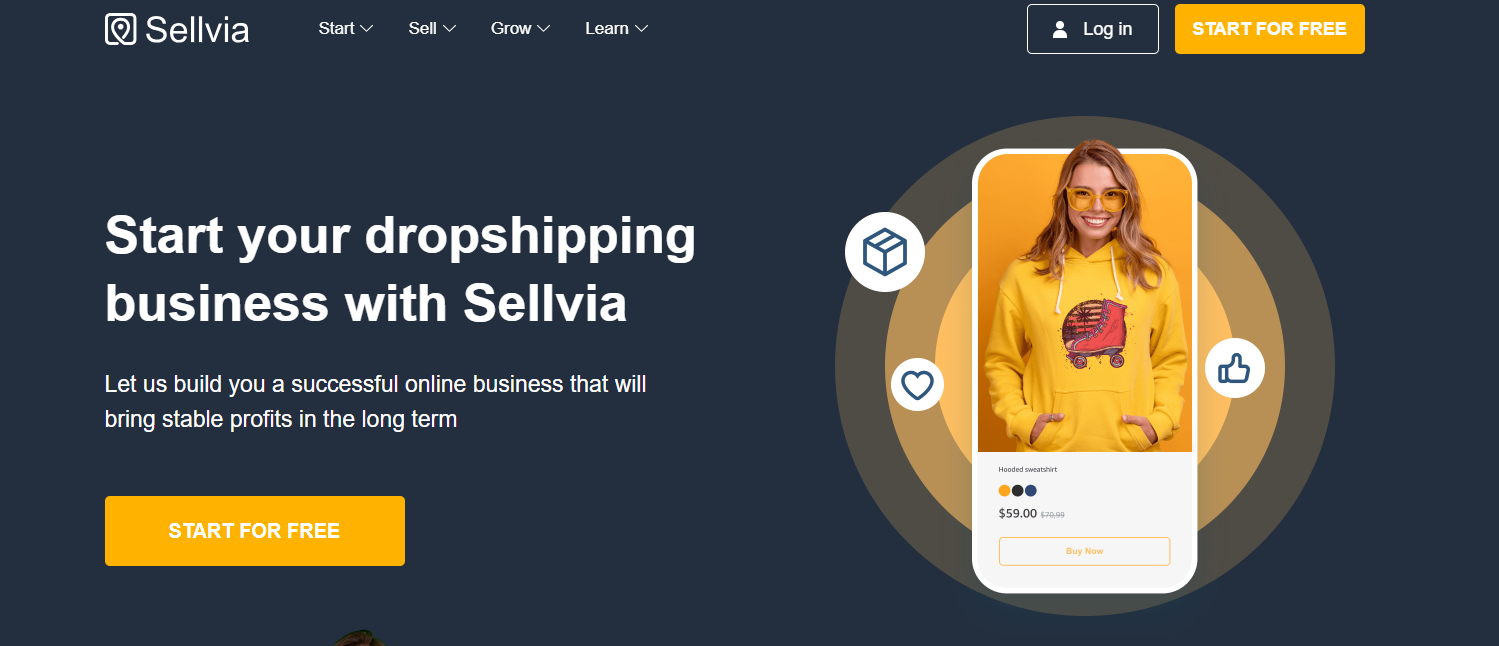
Sellvia is a newer dropshipping supplier that has been making waves for its speed. Originally created to serve US dropshippers, Sellvia stocks products in its own California warehouse and claims customers can receive orders in as little as five days, regardless of location. They have also expanded with global warehouses, aiming to keep delivery under a week worldwide. Sellvia offers a catalog of popular products (tech, accessories, home, etc.), and interestingly it can integrate not only with Shopify/WooCommerce but even allows you to dropship on marketplaces like Amazon. They also offer turnkey services like pre-built stores. Sellvia isn’t free – it typically charges a monthly subscription for access – but if you’re targeting the U.S. market and want nearly Prime-level shipping, it could pay off. This supplier is an offshoot of the AliDropship team, focusing on solving the slow shipping problem that plagues AliExpress. Recommended for those who want to run a US-based store with very fast shipping as their key selling point. (It can be a great choice for niche stores where quick delivery is expected, like electronics or trendy apparel.)
Honorable mentions for fast shipping: Trendsi – a fashion-focused platform we’ll cover below in niche suppliers, but it’s worth noting here that Trendsi offers 2-5 day shipping on apparel shipped from their US warehouses, making it one of the fastest options for clothing dropshipping. Also, keep in mind that some dropshippers use retail giants as suppliers for speed – for instance, using Amazon, Walmart, or Home Depot to fulfill orders (often via automation tools). While not “official” dropshipping suppliers, these retailers can deliver within 2-3 days in the US. However, relying on retail arbitrage can be risky (inconsistent stock, possible account issues), so the dedicated services like those above are generally safer for building a long-term business.
Budget-First Choices: Best Dropshipping Sites with Low Fees
If you’re just starting out or operating on a tight budget, you’ll want suppliers that don’t charge hefty memberships or middleman fees. The following dropshipping websites are either free to use or very low cost, allowing you to source products without eating into your budget. They might not all be the fastest, but they are cost-effective and can be great for testing the waters in e-commerce.
1. AliExpress – Huge Product Range with Zero Platform Fees

It’s impossible to talk about dropshipping on a budget without mentioning AliExpress. AliExpress is a massive online marketplace (run by Alibaba) where countless manufacturers and wholesalers list products at rock-bottom prices. For dropshippers, the key appeal is no upfront cost – you can browse and pick products to sell, and you only pay the product cost and shipping when you get an order (there are no subscription or usage fees to use AliExpress). The catalog is mind-bogglingly large (hundreds of millions of listings), meaning you can find almost any product or niche. This makes it ideal for beginners to test different products without financial commitment. The trade-off: shipping times can be long for many items, since most suppliers are in China. Standard AliExpress shipping to the U.S. or Europe might take 15–45 days in transit, which can strain customer patience. However, there are exceptions – many AliExpress sellers now offer ePacket or special lines that deliver in 7-14 days, and AliExpress also launched a U.S. warehouse program for faster local shipping. Still, cost-wise, AliExpress is king: it’s free, and prices per item are often extremely low, allowing higher margins (just watch out for shipping fees on a per item basis). Pro tip: use an app like DSers (mentioned later) to integrate AliExpress with your store for free, making order processing much easier.
2. Wholesale Central – Free Directory of U.S. Wholesalers
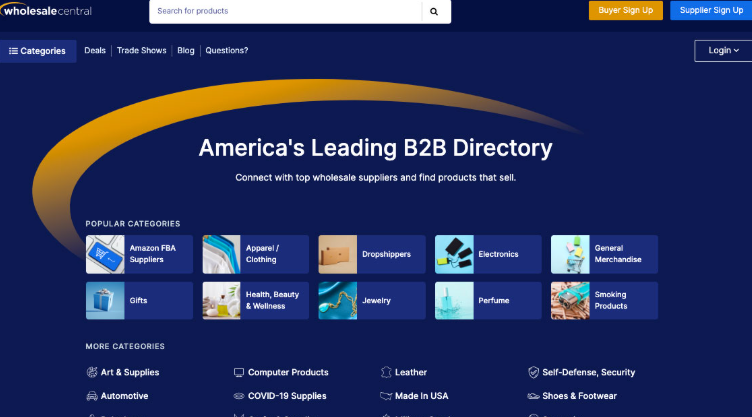
Wholesale Central is a completely free supplier directory that lists thousands of wholesalers, including those that offer dropshipping. Unlike some directories, Wholesale Central doesn’t charge you anything to search and use it; instead they charge the suppliers a listing fee, and they vet each supplier in the directory to ensure legitimacy. This is a great budget-friendly way to find U.S.-based suppliers for all kinds of products – from apparel and electronics to gift items. On their site you can filter by dropshippers and by product categories, then contact the suppliers directly. Since it’s not a fancy integrated platform, you will be doing some legwork (manually uploading products, placing orders with each supplier, etc.), but the upside is no middleman fees at all. Many suppliers you find on Wholesale Central will have reasonable domestic shipping times since they’re based in the U.S., but do check each supplier’s policies. It’s recommended for sellers who don’t mind a bit of manual process to save money. For example, a small boutique owner could use Wholesale Central to find a niche U.S. supplier for organic skincare products and work out a dropship arrangement, all without paying a cent to any “platform.”
3.Eprolo – Free All-in-One Dropshipping Platform
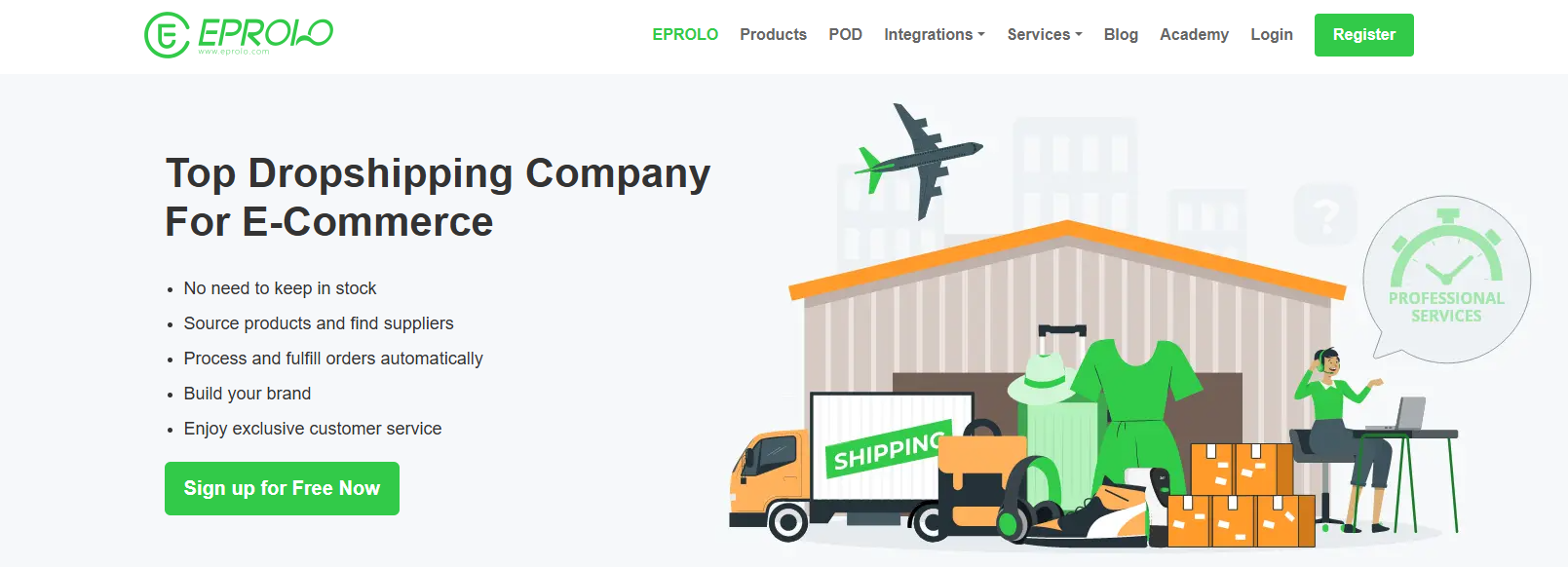
Eprolo is a lesser-known yet nifty free platform that combines the product sourcing breadth of AliExpress with some of the integration perks of an app. Like AliExpress, Eprolo lets you source a wide range of products (clothing, electronics, home decor, etc.), largely from Chinese manufacturers, but it also has its own US and UK warehouses for certain items to enable faster shipping. Eprolo’s service is free to use; they make money by fulfilling the orders (similar to AliExpress model). One cool feature is that Eprolo offers branding services – for example, you can put your custom logo on packaging or even create a branded product line through them once you start selling consistently. Shipping-wise, for products they stock in the U.S. or UK, customers can get them quickly (in a matter of days); for products from China, the shipping is more standard (1-3 weeks) but they claim to optimize routes for reasonable delivery times. Recommended for beginners who want an AliExpress alternative with a unified dashboard – Eprolo provides an order tracking system and automates some of the process for you, which you normally only get with paid apps. It’s not as massive as AliExpress in selection, but it’s growing, and since it costs nothing, it’s worth a look, especially if you’re aiming to build a brand (their ability to do private labeling is handy once you find a winning product).
Other budget-friendly notes: Many of the “all-in-one” platforms we listed earlier (like CJ Dropshipping, Spocket, etc.) have free plans or at least free trials, so you can start with them at no cost as well. For instance, Spocket’s basic plan is $0/month for a limited number of products – ideal for testing. Alibaba (AliExpress’s big brother) is another route to find cheap products; it’s a marketplace for bulk buying, but some suppliers are open to dropshipping if you communicate with them. Just be cautious: Alibaba suppliers expect negotiation and bulk orders, so it’s not plug-and-play like AliExpress. Finally, if you’re technically inclined and really want to avoid any fees, you can manually source products and list them (say from sites like Banggood or Temu which offer cheap goods with low shipping cost). But the hassle factor is high without an integration, so leveraging the free platforms above is usually a better move for beginners.
Niche Masters: Top Websites for Specific Product Categories
Sometimes the “best” supplier for you is one that specializes in your chosen niche. Specialized dropshipping suppliers can offer curated product selections, industry expertise, and even brand cachet that general marketplaces can’t match. Here are some top dropshipping websites excelling in specific categories:
1. Printful – Print-on-Demand for Custom Products (Fast and Global)
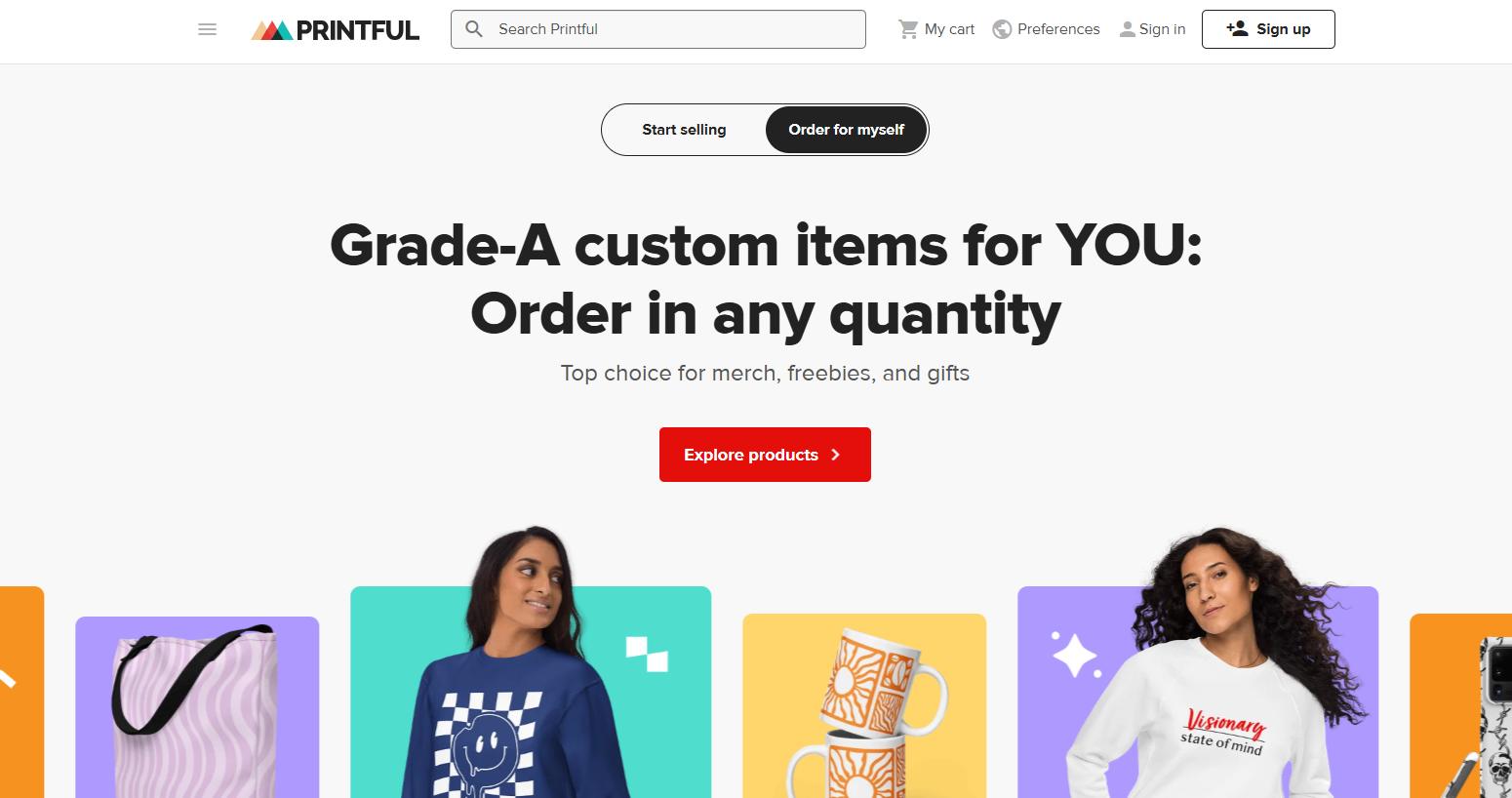
If your niche is custom apparel or merchandise (think T-shirts with unique designs, mugs, wall art, etc.), Printful is the go-to dropshipping partner. Printful is a print-on-demand (POD) supplier – you design or choose the graphics, and they print and fulfill the item only when you receive an order. They stand out for their quality and speed. Printful operates fulfillment centers across the US and in multiple countries (Canada, UK, Europe, even Japan and Australia), which means products are produced and shipped from a location close to your customer. As a result, shipping is quite fast for a custom-made product – often just 3-7 days for domestic orders and a bit more for international. Printful’s product range is broad: not just shirts and hoodies, but also hats, phone cases, posters, pillows, and more, all customizable. There are no upfront fees to use Printful; you only pay the base cost of the product and printing when an order comes in. The integration side is strong too – Printful plugs into Shopify, WooCommerce, Etsy, and others easily, automating order flow. This supplier is perfect for artists, influencers, or any seller who wants to offer unique branded merchandise without holding inventory. The ability to order samples is a nice perk – you can test the product quality yourself before selling. Overall, Printful mastered its niche by combining reasonable turnaround times with made-to-order flexibility, ensuring your customers get a one-of-a-kind product nearly as fast as a stocked item.
2. Trendsi – Fashion Dropshipping from US Brands
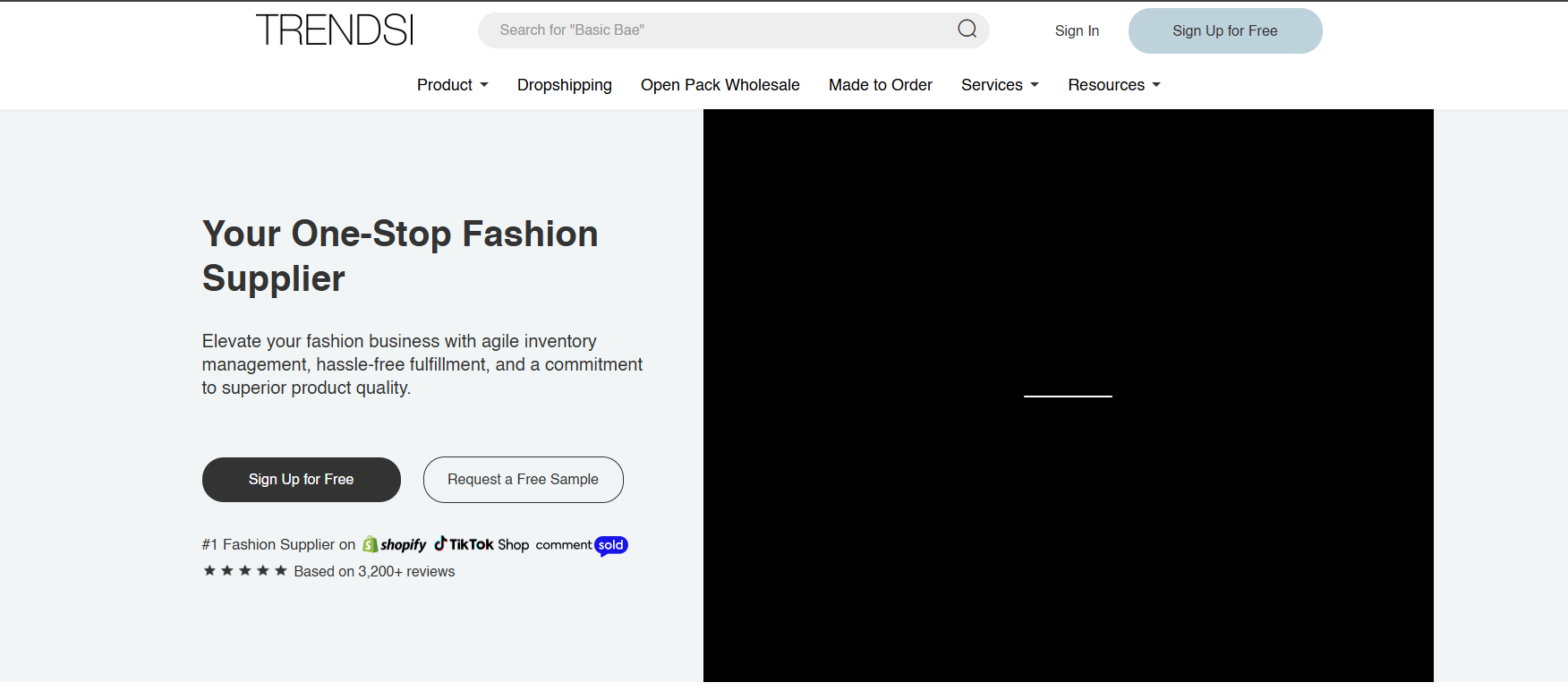
For those in the fashion and apparel niche, Trendsi has rapidly become a top choice. Trendsi is a free platform for sourcing women’s (and men’s) fashion that connects you to a network of apparel suppliers, including indie U.S. brands and manufacturers abroad. The catalog is huge (over 100,000 items, from dresses and activewear to shoes and jewelry), but what’s impressive is their logistics: Products that are in Trendsi’s US warehouses ship to your customers in 2–5 business days (within the US) – and they even include branded invoices with your logo if you want. This means as a fashion dropshipper, you can offer nearly boutique-level service (fast delivery, custom packaging) without storing any inventory yourself. Trendsi also handles returns on your behalf for those US-shipped items (they offer a seven-day free return policy), which is rare in dropshipping and very valuable in fashion where fit issues can cause returns. The platform integrates with Shopify and is quite user-friendly – you can import products with professional photos and extended size charts, which is great for presenting a polished storefront. Recommended for boutique owners, clothing influencers, or really any dropshipper who wants to sell apparel with minimal hassle and quick turnaround. Customers have noted that Trendsi’s selection is trendy and high-quality, and many pieces come from known U.S. boutique brands (so you’re not just selling the same generic outfits as everyone else).
3. Megagoods – Niche Electronics and Gadgets Distributor

If electronics or tech gadgets are your chosen niche, partnering with a specialist like Megagoods can give you an edge. Megagoods is a wholesale distributor that offers dropshipping for a curated list of electronics and tech accessories – think gaming gear, audio equipment, kitchen appliances, etc.. They specialize particularly in consumer electronics and have been around for quite a while. Megagoods operates out of California and has warehouses across the U.S., enabling fast shipping nationwide for the products they carry. Unlike open marketplaces, Megagoods is a membership-based site (with a very low monthly fee, around $14). For that, you get access to brand-name electronics at near-wholesale prices and the ability to dropship them under your business name. For example, you could list a popular brand’s car stereo or a new gaming accessory on your site, and Megagoods will fulfill it to your customer. Why use a niche electronics supplier? Because electronics buyers expect reliability – they want authentic products and quick delivery, and Megagoods provides that by sourcing directly and shipping from the US. This supplier is ideal for sellers in the electronics niche who want to ensure product authenticity and decent margins. Just remember that with branded electronics, margins can be thinner than, say, fashion or accessories. The upside is you’re offering items with proven demand (everyone needs gadgets), and Megagoods simplifies the supply chain for you.
Other niche-focused suppliers to consider: Pet Stores USA – As the name implies, a dropshipping supplier just for pet products (toys, pet food, accessories). They have a warehouse in Ohio and ship pet goods across the US. If you’re building a pet niche store, working with a dedicated pet product distributor like this ensures you get a wide selection of quality pet items with domestic shipping. BrandsGateway – A luxury fashion dropshipping supplier that offers high-end branded apparel and accessories (think Prada, Dolce & Gabbana, etc.) for those targeting the luxury market. They ship globally via DHL and can deliver in a few days, but note you’ll need a significant budget (their items are costly and there’s a monthly fee to access the platform). Printify – a competitor to Printful that connects you with a network of print providers worldwide. It’s also great for print-on-demand, often with slightly lower base prices, and integrates with Shopify, Etsy, WooCommerce and more. Printify, like Printful, lets you order samples and has print providers in 90+ locations, which helps keep shipping times down. In summary, if you have a clear niche, chances are there’s a specialized dropship supplier or marketplace for it – leveraging these can differentiate your store with unique inventory or superior service in that category.
The Integrators: Best Dropshipping Platforms for Shopify & WooCommerce
This category is all about the tools and platforms that make dropshipping easier through integration. If you run your store on Shopify, WooCommerce, or another e-commerce platform, the following services act as bridges between your store and various suppliers. They’re not always “suppliers” themselves (though some have their own networks), but they enable you to import products, sync inventory, and automate orders with minimal fuss. Essentially, they are the glue that connects your shop to the dropshipping world.
1. DSers – Optimized AliExpress Integration for Shopify

DSers is a must-have tool if AliExpress is one of your main product sources. After Shopify’s famous Oberlo app was discontinued, DSers became the official replacement for AliExpress dropshipping on Shopify. What does it do? DSers connects your online store directly with AliExpress suppliers and lets you bulk-import products and automate order fulfillment. Instead of manually ordering each product on AliExpress for every sale, DSers will automatically send the order to the AliExpress supplier, fill in your customer’s address, and even choose ePacket or other shipping for you. It also has a Supplier Optimizer feature: if an item is sold by multiple AliExpress vendors, DSers helps you compare options (price, ratings, shipping) and switch to better suppliers easily. The app is free for basic use (up to a certain number of orders per month), which is great for beginners. DSers is recommended for e-commerce owners who want a faster, more efficient way to work with AliExpress. It eliminates much of the tedium and reduces errors in order processing. There’s also a WooCommerce version and a Wix integration of DSers, so it’s not limited to Shopify. If you plan to cast a wide net of products from AliExpress (which many beginners do due to its variety), DSers will save you countless hours and help scale your operation smoothly.
2. Dropified – Multi-Supplier Automation for Shopify & WooCommerce

Dropified is another powerful integration tool that not only works with AliExpress but also lets you import from dozens of other sources (eBay, Walmart, Costco, and select US suppliers, etc.). It started as a simple Chrome extension and has evolved into a full-fledged platform for automating dropshipping tasks. Dropified integrates with Shopify, WooCommerce, and more and supports one-click product importing and one-click order fulfillment across its supported sites. One standout feature: Dropified has a range of extra bells and whistles like an automated price change and stock level update – if a supplier changes a price or runs out of stock, Dropified can auto-update your store listing so you don’t sell something that isn’t available. It even offers some marketing help, like pulling in product reviews or helping create Google Shopping feeds. While Dropified isn’t free (there’s a monthly subscription after a free plan or trial for a few products), many store owners find that the time saved and errors avoided are worth it. Recommended for those who source from multiple suppliers and platforms and want a unified automation tool. For example, if you want to dropship a mix of AliExpress goods, plus some Walmart items, plus maybe a niche supplier that Dropified supports, you can manage all of that in one place. It’s like having a virtual assistant that handles the busywork. (It’s also popular among WooCommerce users since DSers was very Shopify-centric; Dropified fills that gap.)
3. Inventory Source – 230+ Supplier Integrations for Serious Sellers

Inventory Source is a bit more of a heavy-duty integrator geared towards established or scaling businesses. It offers over 230 pre-built integrations with wholesale suppliers across countless categories. Unlike DSers or Dropified which often center on retail marketplaces, Inventory Source focuses on true wholesale dropship suppliers (many of which are USA-based). The platform will sync product data and inventory from these suppliers directly to your online store and can automate order routing as well. It supports more than 25 e-commerce platforms, including Shopify, WooCommerce, BigCommerce, Magento, Amazon, eBay, etc.. Basically, if you find a supplier in their network, Inventory Source can connect it to your store so that products show up with up-to-date stock counts, and orders flow back to the supplier. This is extremely useful if you use multiple niche suppliers – you don’t want to manually upload CSV files of inventory every day for each. Inventory Source has a free plan to just browse suppliers, but the automation features come in paid tiers (starting around $99/month). It’s recommended for more established dropshippers or those who want to scale up with many suppliers and SKUs. For instance, let’s say you run a motorsports online store and use 5 different auto-parts dropship suppliers; Inventory Source could connect all five to your site and keep everything in sync. It takes the IT burden off your shoulders. While it might be overkill for a newbie with one or two suppliers, it’s a lifesaver for complex operations.
Other integration tools worth noting: Syncee – an app that acts both as a supplier marketplace and an integration tool. It has a free plan (import up to 25 products) and connects merchants to over 12,000 brand suppliers worldwide. Syncee is noted for its easy automated synchronization of inventory and orders, and many suppliers on Syncee are wholesalers willing to dropship, so you can scale from dropshipping to wholesale as you grow. AutoDS – a platform that started for eBay automation and now supports Shopify and Facebook shops. It lets you auto-order and sync tracking from retailers like Amazon, Walmart, and more. AutoDS is popular for those doing retail dropshipping at scale (e.g. managing hundreds of eBay listings). Oberlo (legacy) – while Oberlo is gone, its spirit lives on in these integration tools we mentioned. If you come across old advice about “use Oberlo for Shopify”, just replace that with DSers now. The key point: integration apps are your friend for eliminating repetitive tasks and avoiding costly mistakes. When your business starts to grow, these tools become essential to maintain efficiency.
Side-by-Side Comparison: Fast Shipping vs. Low Fees vs. Product Range
Every dropshipping website has its strengths and weaknesses. When choosing one, you often have to balance between shipping speed, costs, and product range. Here’s a quick comparison to help weigh what matters most for you:
-
Fast Shipping vs. Slow Shipping (Overseas): Platforms like DropCommerce or Trendsi that source domestically can get orders to your customers in under a week. In contrast, a giant marketplace like AliExpress might have virtually any product you can imagine, but standard shipping from overseas could take 15–45 days for delivery. Fast shipping keeps customers happy, but you might sacrifice some variety or pay a bit more per item for local inventory. If rapid delivery is a cornerstone of your brand, lean toward suppliers with local warehouses or fast-ship programs. If you’re okay with longer shipping (say, for one-of-a-kind products or if your customers know it’s custom-made/coming from abroad), then broad marketplaces are back on the table.
-
No/Low Fees vs. Membership Costs: Free options (AliExpress, Wholesale Central, CJ Dropshipping, etc.) let you start selling without any overhead fees. This is great for testing products and keeping costs down. However, some paid services (like SaleHoo, Spocket’s paid plans, Doba, etc.) charge fees in exchange for value-adds like vetting suppliers, faster shipping, or automation tools. The question is whether those features will either save you time or make you more money than the fee costs. For a beginner, it usually makes sense to start with free or low-cost options until you have some sales volume. As you scale, paying for an app that automates your orders or a directory that gives you reliable suppliers might be worth every penny. In general: Use free platforms to maximize your profit margin, but don’t shy away from a paid tool if it directly addresses a pain point in your business (time spent, lack of quality suppliers, etc.).
-
Wide Product Range vs. Curated Selection: AliExpress and similar marketplaces or large directories offer millions of products, which is ideal if you want to test many niches or offer a very broad catalog. The downside is that not all products are high quality or trending, and you’ll need to do your own vetting. Curated platforms (Spocket’s suppliers, certain niche suppliers) have smaller catalogs but higher average quality and uniqueness. This can save you from selling poor products. It also often means less direct competition on those items, since they’re not oversaturated. If your strategy is to throw up 100 products and see what sticks, a broad source is necessary. If your strategy is to build a brand around, say, eco-friendly home goods, you might prefer to work with a smaller set of trusted suppliers who specialize in that area. Note: You can also mix approaches – use one broad supplier for some products, and complement it with a couple of niche suppliers for your core items.
Example trade-offs: Sourcing from AliExpress is cheap and diverse but you’ll need to handle longer shipping expectations or cherry-pick sellers who can ship faster. Using Spocket or local suppliers gives you speed and quality but you might pay monthly fees and have access to a narrower inventory. Directories like Wholesale Central are free and let you find reliable domestic suppliers, but you won’t get automation – more manual effort is required to actually list and sell those items. Ultimately, there’s no one-size-fits-all; the “best” choice depends on your business priorities (fast shipping vs. low cost vs. unique product range). Many successful dropshippers use a combination: for instance, sourcing staple products from a fast local supplier, and supplementing their catalog with a few hot trending items from overseas suppliers despite the slower shipping. This way, you satisfy the need for quick delivery on most orders while still capitalizing on ultra-cheap or unique finds internationally.
Beyond the List: 5 Steps to Choose the RIGHT Dropshipping Website for You
Finding a list of top suppliers is a great start, but how do you decide which dropshipping website or supplier is the perfect fit for your specific business? Here’s a simple 5-step plan to help you make that decision, going beyond just picking from a list:
1. Define Your Business Priorities and Niche.
Begin by clearly identifying what matters most for your store. Is it shipping speed, product cost, or a very specific product niche/quality? Also, consider your target market: Are your customers mostly in one country or worldwide? For example, if you plan to sell high-end skincare to US customers, you’ll prioritize a US supplier for quality and fast shipping. If you run a fun gadget store targeting bargain hunters globally, you might prioritize a huge product range at low cost. Knowing your niche and value proposition will narrow down suitable suppliers. Write down your must-haves (e.g., “delivery under 1 week” or “no membership fee” or “must integrate with Shopify” etc.) – this becomes your checklist when evaluating suppliers.
2. Research and Shortlist Potential Suppliers.
Use multiple avenues to find candidates: the curated list above, search engines, supplier directories, and dropshipping communities. A simple Google search like “<Your niche> + dropshipping supplier” can yield good leads. Supplier directories (like SaleHoo or Worldwide Brands) can help you discover reliable wholesalers in your niche. Check forums, Facebook groups, or Reddit (for example r/dropship) for threads where people discuss suppliers – often you’ll find real experiences there. Compile a shortlist of perhaps 3-5 supplier platforms that seem to match your criteria from Step 1. Ensure you’re looking at up-to-date info (in 2025, new suppliers like Trendsi or Sellvia might be the ones people talk about, whereas older blog posts could be outdated). At this stage, also visit the supplier’s website or app listing. Look at their product catalog, pricing, shipping info, and any reviews or case studies they provide. If possible, read reviews from other merchants about that supplier – a quick search like “<Supplier name> reviews” can show if people have had major issues or love it.
3. Evaluate Supplier Details (Shipping, Fees, Support) and Test the Waters.
Now compare your shortlist on key parameters. How fast do they ship to your main customer regions? What are the shipping costs like? Do they charge any monthly fee, per-order fee, or require a bulk buy-in? Also, assess their ease of use: Do they integrate with your e-commerce platform or will you be manually placing orders? Don’t forget to check their customer support and policies – can you contact someone if an order goes wrong? What’s their return policy for damaged items? Once you’ve done a paper evaluation, it’s time to test the supplier. The best way to know if a supplier is reliable is to place a trial order for a product to yourself. This lets you experience their shipping speed, packaging, and product quality first-hand. For example, if Supplier X claims 3-5 day shipping, order an item and see if it arrives in that timeframe. While doing this, also try contacting their support with a question to see how responsive they are. This real-world test can save you from unpleasant surprises after you’ve already committed your customers to that supplier’s service. It’s better to discover issues now than when you have ten customer orders waiting.
4. Look at Integration and Scalability.
Consider how well the supplier will fit into your business as it grows. If you’re on Shopify or WooCommerce, does the supplier have an app or plugin for one-click importing and automatic order fulfillment? A supplier might be awesome in products and price, but if you have to manually email every order, it could bottleneck you in the future. Check if the supplier platform provides inventory sync (to avoid selling out-of-stock products) or an easy way to update product info. Also, think about scaling your product range: As you grow, will this supplier be able to offer more products or new categories? If not, you may need to juggle multiple suppliers. That’s not a deal-breaker (many stores use 2-3 suppliers), but then ensure you have a plan for managing that, perhaps by using an integration tool like Inventory Source or a platform that aggregates multiple suppliers. In short, choose a supplier that not only meets your needs now, but will also support your ambitions 6-12 months down the line – whether that’s selling thousands of orders a month or expanding into new niches.
5. Match Suppliers to Your Seller Type & Make the Final Decision.
By now, you likely have one or two frontrunners. To finalize, reflect on what “seller type” you are and which supplier aligns with it (see next section for guidance). For instance, if you realize you’re a beginner who just needs something simple and forgiving, you might lean toward a supplier with a free plan and lots of support tutorials (and maybe not the one that requires a high monthly fee and assumes you’re a pro). If you are a branding-focused seller, you’ll pick the supplier that allows custom packaging or white labeling. Once you identify which supplier best matches your style and audience expectations, go ahead and commit to it. This means integrating it fully: upload a range of products from them to your store, set up your shipping settings in line with their delivery times, and perhaps even form a direct line of communication with an account manager or support contact there.
Finally, don’t be afraid to re-evaluate over time. The dropshipping landscape evolves quickly – new suppliers emerge, existing ones improve or worsen. Continuously monitor performance. If your initial choice isn’t working out (maybe shipping slips or product quality drops), you can switch or add new suppliers using the same process above. The goal is to arrive at a reliable supply chain that keeps your customers happy and your business growing.
How to Test a Supplier Before You List Their Products
Before fully committing to any supplier, it’s wise to test them thoroughly. We touched on this in the steps above, but let’s break down a few concrete ways to vet a supplier:
-
Order Sample Products: This is the golden rule – always order one or two products as a customer would. See how the process goes. Did you get a tracking number promptly? How long did delivery actually take versus the claim? When the product arrives, inspect the packaging and item quality. This experience will mirror what your customer will go through. It’s even better if you can order a sample to someone else (to test address accuracy and perhaps how it looks when delivered to a fresh address). Some platforms like Printify encourage ordering samples and even offer them at a discount. It’s a small investment for peace of mind.
-
Evaluate Communication: Send the supplier a couple of questions via email or chat as if you were a business partner (which you are). For example, ask about bulk pricing, or how they handle an out-of-stock situation, or if they offer expedited shipping options. The quality and speed of their response will tell you a lot. A supplier that replies within 24 hours with a clear, helpful answer is a good sign. If you struggle to get a response or only receive very vague answers, imagine how it might be when you have a real issue with an order.
-
Check Reviews and Ask in Communities: Look up the supplier’s name on forums or Facebook groups. See if other dropshippers have reported problems or great experiences. You can even make a post asking, “Has anyone used [Supplier] recently? What’s your experience with shipping times and customer service?” Dropshipping communities are usually willing to share. Also, search on YouTube – often, entrepreneurs post review videos of platforms (e.g., “Spocket review” or “Zendrop vs CJ Dropshipping”). While individual opinions vary, you might catch common themes (e.g., “supplier X had a problem syncing tracking numbers” or “supplier Y’s product quality was top-notch”).
-
Verify Supplier Credibility: For lesser-known suppliers (especially if you found them on a directory or Google), do a credibility check. Is their website professional? Do they list a physical address and phone number? If it’s a directory like Wholesale Central that screens suppliers, that adds some trust. But if you’re dealing with a random overseas supplier you found, consider asking for references or even looking up their business on sites like Alibaba or LinkedIn to ensure they are legitimate. In dropshipping, you typically won’t encounter outright fraud when using the popular platforms, but due diligence is never a bad idea if something feels off.
-
Test Small Before Scaling: Instead of adding 200 products from a new supplier and blasting ads, start with a small subset. Maybe list 5-10 products and see how the supplier handles those orders. This limited test-run can reveal issues with inventory sync, product descriptions, or order handling that you can fix or decide “no-go” before your whole store is affected. It’s much easier to course-correct early on.
By thoroughly testing a supplier, you essentially simulate the customer experience and catch red flags in advance. As one expert noted, “the surest way to verify a supplier’s speed is by ordering an item from them and noting how fast it gets to you,” plus doing your research on third-party opinions. Invest a bit of time and possibly money in this validation phase – it can save your store’s reputation and ensure you’re building on a solid foundation of reliable suppliers.
Integrations: Platforms & Plugins to Make Scaling Easier
When you move from a handful of orders per week to dozens or more per day, manual management can become a nightmare. That’s where integrations and automation tools come in – they help you scale gracefully by connecting your store to your suppliers and streamlining operations. Here are some integration options and plugins that can make your life easier as you grow:
-
E-commerce Platform Apps: If you’re on Shopify, the Shopify App Store is full of dropshipping integrations (many we’ve discussed: CJdropshipping, Spocket, Syncee, Printful, etc.). Install the app for your chosen supplier if available – this will typically enable one-click product imports and automated order fulfillment. For WooCommerce (WordPress), plugins like Dropified or specific supplier plugins (e.g., a WooCommerce plugin for Printful or CJ) serve a similar function. Utilizing these apps means when someone orders from your website, the order is automatically forwarded to the supplier with all the correct info, and often the tracking number gets synced back to your store once shipped. This not only saves time but also reduces errors (no more copy-pasting addresses incorrectly).
-
Order and Inventory Management Tools: If you work with multiple suppliers or also sell on multiple channels (like your own site plus eBay/Amazon), consider an order management system. There are tools like Orderhive, Sellbrite, or Inventory Source’s system that gather all orders in one dashboard and route them to the right supplier. They can also keep inventory counts updated across platforms. For example, if Supplier A runs out of a product, the tool can hide or mark it out-of-stock on all your sales channels. These tools ensure you don’t accidentally oversell a product that one supplier can’t fulfill. Some advanced ones will even allow “routing rules” – e.g., if you have two suppliers for similar products, it can send the order to the one closer to the customer to deliver faster, etc..
-
Price Automation and Tracking: As you scale, manually updating prices due to supplier changes becomes impractical. Integration tools like DSers, Dropified, or custom solutions via API can automatically adjust your store’s prices if the supplier changes theirs. For instance, you might set a rule to always price 50% above the supplier’s price – if they hike a cost, your retail price goes up accordingly so you don’t lose margin. Tracking integration is another big help: many dropshipping apps will pull the tracking number from the supplier and send it to your customer via your store, so you don’t have to do it manually. Customers stay informed without you writing a single email.
-
API Integrations for Custom Solutions: Some advanced suppliers or platforms offer API access (Application Programming Interface). If you have development skills or can hire a developer, APIs let you create custom integrations beyond what off-the-shelf apps do. For example, maybe you have a unique need like automatically delisting products if the supplier’s stock falls below 5 units – an API can allow you to implement that kind of specific rule. This is more relevant when you’re operating at a larger scale or have very particular workflows. The good news is many popular suppliers (CJdropshipping, Spocket, etc.) already have robust apps, so APIs are usually a backup for edge cases.
-
Outsourcing and Virtual Assistants: While not a “plugin”, another way to ease scaling pain is to outsource tasks. Once your order volume is high enough, you might hire a virtual assistant to handle customer emails or even manually place orders for suppliers that lack automation. However, leveraging software is usually more cost-effective than human labor for repetitive tasks. Use humans for the tasks that require judgment or great customer care, and let integrations handle the repetitive syncing and updating.
In summary, take advantage of technology to do the heavy lifting. A dropshipping business can be run by one person even at fairly high volume precisely because so much can be automated or streamlined. As one example, a user of Zendrop might wake up to find that all their Shopify orders from yesterday have already been processed and tracking numbers emailed to customers, without them clicking a button. That frees you to focus on growth activities (marketing, adding new products, improving your site) instead of drowning in fulfillment tasks. Plan for integration early – even if you don’t need it on day one, setting it up properly will set you up for smooth scaling.
Final Verdict & Recommended Picks by Seller Type
We’ve covered a lot of ground – from the importance of supplier choice to the top websites and how to choose. Now, as a final summary, here are our recommended picks based on what type of seller you are:
-
If you’re a complete beginner (on a shoestring budget): Start with AliExpress via DSers. It’s free, gives you millions of products to experiment with, and DSers will simplify the process of managing orders. Yes, be mindful of shipping times; focus on ePacket or suppliers with good ratings for faster delivery. Also, try a free plan on Spocket or CJ Dropshipping for some domestic products – you can mix a few fast-shipping items into your store to keep some customers happy while you learn the ropes. These options won’t cost you anything upfront, which is perfect for learning and testing.
-
If you prioritize speed and customer experience: Go with a supplier like DropCommerce or Spocket for primarily US/EU-sourced products (3-5 day delivery). Or use Sellvia if you target the US market exclusively for its Amazon-like speed. Your store can then boast quick shipping in all your marketing. You might pay a subscription or slightly higher wholesale prices, but you’ll likely earn it back in higher conversion rates and fewer customer complaints. Pair it with a solid integration (these platforms have Shopify apps, etc.) and you’ll deliver a smooth experience rivaling big-box retailers.
-
If you’re focused on a specific niche or branding: Choose a niche specialist like Printful/Printify for print-on-demand (branding and custom products), Trendsi for fashion (trendy clothes with your branding on invoices), or Pet Stores USA for pet goods (if that’s your niche, having a dedicated pet supply partner is gold). Niche suppliers can elevate your brand’s perceived expertise. You can confidently say “we partner with the best in [your niche].” Just ensure that niche supplier covers your key needs (quality, reasonable shipping to your audience, etc.). Often, niche suppliers have decent integration too, but if not, be ready to handle a bit more manually or find a third-party tool.
-
If you are an international seller or multi-niche experimenter: A platform like CJ Dropshipping or Zendrop is ideal. They ship globally fairly quickly and have a wide variety of products. CJ in particular can help source items for you if something you want isn’t listed. These platforms make it easier to serve customers in different countries by routing orders to the closest warehouse. So if you’re running ad campaigns in multiple countries or haven’t narrowed down a niche yet, they provide a flexible backbone.
-
If you’re scaling up or running multiple stores: Look into Inventory Source or Wholesale2B to manage multiple suppliers in one system. And consider SaleHoo or Worldwide Brands to find additional reliable suppliers as you expand into new product lines (especially if you want to add branded or tougher-to-find products). At this stage, investing in a paid directory or automation tool can dramatically increase efficiency. For high-volume sellers, also establish direct relationships – for example, use SaleHoo to find a great supplier, then negotiate bulk pricing or special terms once you start doing significant volume with them. This hybrid approach (tech + relationships) is what many 7-figure dropshippers use to stay ahead.
In the end, the “best” dropshipping website for you is the one that aligns with your business model and helps you keep customers happy. The good news is you don’t have to marry just one supplier – many successful stores use 2-3 in harmony. For instance, one might use CJdropshipping to test new items cheaply, Spocket to supply best-sellers with fast shipping, and Printful to offer some custom merch on the side. As you gain experience, you’ll refine your mix. Keep an eye on performance and don’t hesitate to switch if a supplier isn’t meeting expectations. With the insights and list we’ve provided, you have a strong starting point to build a resilient, profitable dropshipping business in 2025 and beyond.
FAQ (Frequently Asked Questions)
Q: What is the best dropshipping website for beginners?
A: For most beginners, the best option is to use a large, no-cost platform like CJdropshipping paired with an automation tool (e.g. CJdropshipping on Shopify). CJdropshipping offers a huge product selection with zero upfront fees, making it easy to experiment without much risk.
Q: Which dropshipping suppliers offer the fastest shipping?
A: Suppliers with domestic warehouses or localized fulfillment offer the fastest shipping. For example, DropCommerce works with US/Canada suppliers and can deliver in about 3–5 days within North America. Fashion supplier CJdropshipping ships from US warehouses in as fast as 2–5 days for domestic orders. Niche wholesalers like Richard Cannon (jewelry) even achieve 1–2 day shipping in some cases.
Q: What is the cheapest dropshipping supplier (low fees)?
A: AliExpress is often considered the cheapest source for products – it’s free to use and you only pay the wholesale product cost and shipping. Other budget-friendly platforms include CJ Dropshipping, which charge no app fees and offer competitive product pricing. Essentially, any service where you don’t pay monthly fees – you just cover the product and its shipping – will be cheapest per sale. Just remember “cheap” might come with trade-offs in shipping time, so weigh cost vs. speed appropriately.
Q: What is the best dropshipping platform for Shopify?
A: If you’re using Shopify, some of the top dropshipping integrations are CJdropshipping. CJ is highly rated on Shopify for sourcing high-quality products with quick shipping. Printful is another excellent Shopify-integrated platform if you want to sell print-on-demand products. All of these can be installed from the Shopify App Store and will automate key tasks (inventory sync, order fulfillment) so you can manage everything from your Shopify dashboard.

